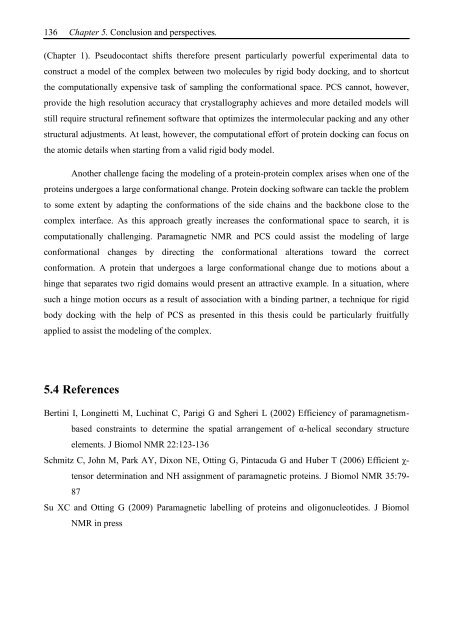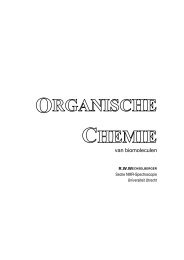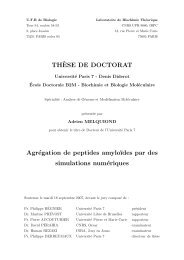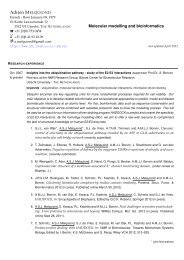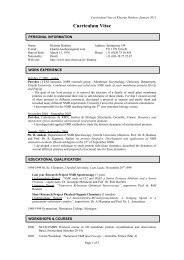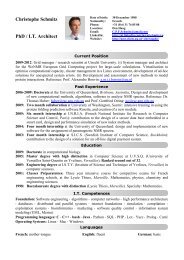Thesis Title: Subtitle - NMR Spectroscopy Research Group
Thesis Title: Subtitle - NMR Spectroscopy Research Group
Thesis Title: Subtitle - NMR Spectroscopy Research Group
Create successful ePaper yourself
Turn your PDF publications into a flip-book with our unique Google optimized e-Paper software.
136 Chapter 5. Conclusion and perspectives.<br />
(Chapter 1). Pseudocontact shifts therefore present particularly powerful experimental data to<br />
construct a model of the complex between two molecules by rigid body docking, and to shortcut<br />
the computationally expensive task of sampling the conformational space. PCS cannot, however,<br />
provide the high resolution accuracy that crystallography achieves and more detailed models will<br />
still require structural refinement software that optimizes the intermolecular packing and any other<br />
structural adjustments. At least, however, the computational effort of protein docking can focus on<br />
the atomic details when starting from a valid rigid body model.<br />
Another challenge facing the modeling of a protein-protein complex arises when one of the<br />
proteins undergoes a large conformational change. Protein docking software can tackle the problem<br />
to some extent by adapting the conformations of the side chains and the backbone close to the<br />
complex interface. As this approach greatly increases the conformational space to search, it is<br />
computationally challenging. Paramagnetic <strong>NMR</strong> and PCS could assist the modeling of large<br />
conformational changes by directing the conformational alterations toward the correct<br />
conformation. A protein that undergoes a large conformational change due to motions about a<br />
hinge that separates two rigid domains would present an attractive example. In a situation, where<br />
such a hinge motion occurs as a result of association with a binding partner, a technique for rigid<br />
body docking with the help of PCS as presented in this thesis could be particularly fruitfully<br />
applied to assist the modeling of the complex.<br />
5.4 References<br />
Bertini I, Longinetti M, Luchinat C, Parigi G and Sgheri L (2002) Efficiency of paramagnetism-<br />
based constraints to determine the spatial arrangement of α-helical secondary structure<br />
elements. J Biomol <strong>NMR</strong> 22:123-136<br />
Schmitz C, John M, Park AY, Dixon NE, Otting G, Pintacuda G and Huber T (2006) Efficient χ-<br />
tensor determination and NH assignment of paramagnetic proteins. J Biomol <strong>NMR</strong> 35:79-<br />
87<br />
Su XC and Otting G (2009) Paramagnetic labelling of proteins and oligonucleotides. J Biomol<br />
<strong>NMR</strong> in press


